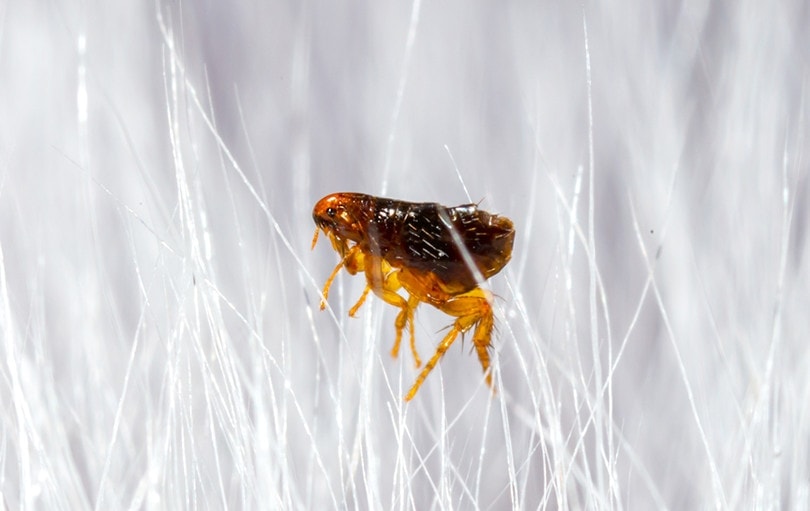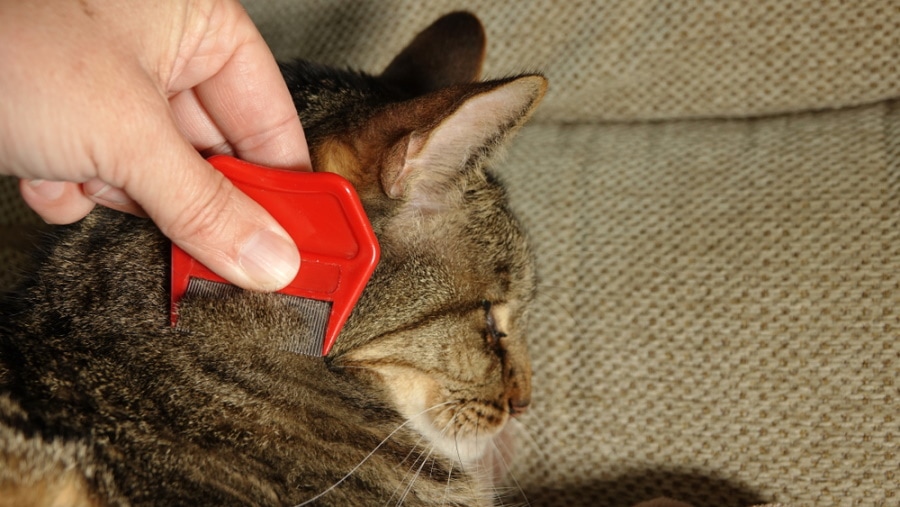
On short, chilly winter days, you’re probably looking forward to a snuggle under a thick warm blanket with your kitty. With hot cocoa in your hand and the blazing days of summer gone like the leaves piled in your yard, it seems like you won’t have to worry about populations of pesky parasites such as fleas. While it is true that fleas require warmer temperatures to thrive, unfortunately, our tightly sealed, climate-controlled houses provide the perfect winter getaway. In fact, the heralding of winter can easily bring on an indoor infestation as these pests seek a warm place to reproduce.
Why Are Fleas a Big Deal?
Unfortunately, fleas cause more than tiny, annoying bites. Fleas can actually host tapeworm larvae in their bodies. When your cat accidentally eats a flea while grooming themselves, these tapeworms will continue their development in their digestive tract and cause all kinds of problems. On very rare occasions, they can even hatch inside humans!
Not to mention, fleas are incredibly difficult to eliminate, and the “flea dirt” is unsightly. Resembling specks of coffee grounds, flea dirt is actually flea excrement. If the dirt becomes wet, it’ll turn red because of the dried blood found in their feces. Gross.
Before you start shaming yourself, let’s say this: most cat parents will encounter a flea infestation at some point. Maybe you were late applying your feline’s flea control, or maybe the bug population that year was so large that a couple of fleas slipped into your house anyway. A single adult flea can lay up to 50 eggs a day. You’re not a bad pet parent—or housekeeper—if you ever encounter an infestation. Unfortunately, it can happen to anybody, but there are ways you can try to prevent the problem in the future. If you do find one, it’s important to deal with it immediately before it gets out of hand.

How Bad Are Fleas in the Winter?
Adult fleas can live in environments as low as 45ºF. Outdoors, fleas usually overwinter in cocoons during the winter. As long as they find a cozy hiding place that stays just above freezing, the fleas will survive until spring.
This is why the flea population seems to dip down during the winter months. They’re simply not as active when it’s cold. However, in environments where it doesn’t reach 45ºF—say, inside your house where your indoor cat lives—they’ll continue living, as usual, all winter long.
Temperatures below 45ºF are also dangerous for your cat. Even if you have an indoor/outdoor or completely outdoor cat, you should bring them in or provide shelter once the temperature drops below 45ºF. Freezing temperatures can quickly cause frostbite and hypothermia, which can be life threatening. Safe to say, your cat is still at risk of becoming infested with fleas during the winter because they also require similar temperatures to be safe from the cold.
How to Prevent Fleas Year-Round
In order to proactively fight the fleas, you’ll need some kind of flea control for your cat throughout the year. Your vet can give you some good ideas of which product is best for your cat. Flea control is the most crucial part of flea prevention since these parasites prefer animals as hosts.
Keeping a clean house can also curb infestations and help you spot one sooner if it does happen. You should aim to wash your and your cat’s bedding in hot water at least once a week. If you have carpet or a sofa, vacuuming once a week helps trap the eggs. Just be sure to dump the dirt outside so they don’t nest somewhere else inside.
You can also sprinkle diatomaceous earth around the perimeter of your house. These tiny, crushed exoskeletons pierce and kill small bugs who may be trying to get inside your home, including fleas and ants. If you choose this method please be sure to wear a face mask during the application. Cat-friendly insect repellent is another great way to dissuade fleas, especially on fabric surfaces you can’t wash, such as sofas and cat towers. Make sure it’s formulated for use around cats first, however, since many insecticides are toxic to our feline friends.

What to Do If You Encounter an Infestation
If you’ve found the flea dirt of doom or uncovered a sickening swarm of fleas, don’t panic. You’ll need to clear your cat from the fleas first. In addition to your veterinarian’s recommendations for flea control, you can also tackle the problem with a flea comb dipped in water and dish soap. Before running to buy an anti-flea product, you should first consult your vet to make sure it’s safe to use on your cat or in combination with any other medicine your cat may be taking, including any other flea control products. Some products can rapidly squelch infestations on your cat by killing all adult fleas within 24 hours. However, you’ll still need to comb them and have a strategy against the flea eggs, which will survive.
In the meantime, you’ll also need to wash all bedding in hot water and thoroughly clean the house. Steam and vacuum all surfaces and crevices around the house. Unfortunately, you may need to repeat the process several times over the next few weeks.
Fleas can’t survive on cold, hard surfaces. Until the problem is gone, try not to have a bunch of soft, fuzzy things lying around your house, such as throw pillows. Soft surfaces provide good places for fleas to hide. Keep your closet door closed, as well as any other areas where your cat may crawl onto fabric surfaces. If fleas are deprived of their host and nesting grounds, it is easier to break their cycle and eradicate them
Summary
While adult fleas can’t survive cold temperatures, warm indoor heaters blazing throughout the winter provide a tropical vacation for these resilient pests. You’ll need to treat your cat with veterinary-prescribed flea control in order to control an infestation, along with washing the bedding and steaming and vacuuming the carpet at least once a week. Since fleas can lay over a hundred eggs every couple of days, it’s important to take preventative measures and react quickly if you do spot an infestation.
Featured Image Credit: KanphotoSS, Shutterstock






